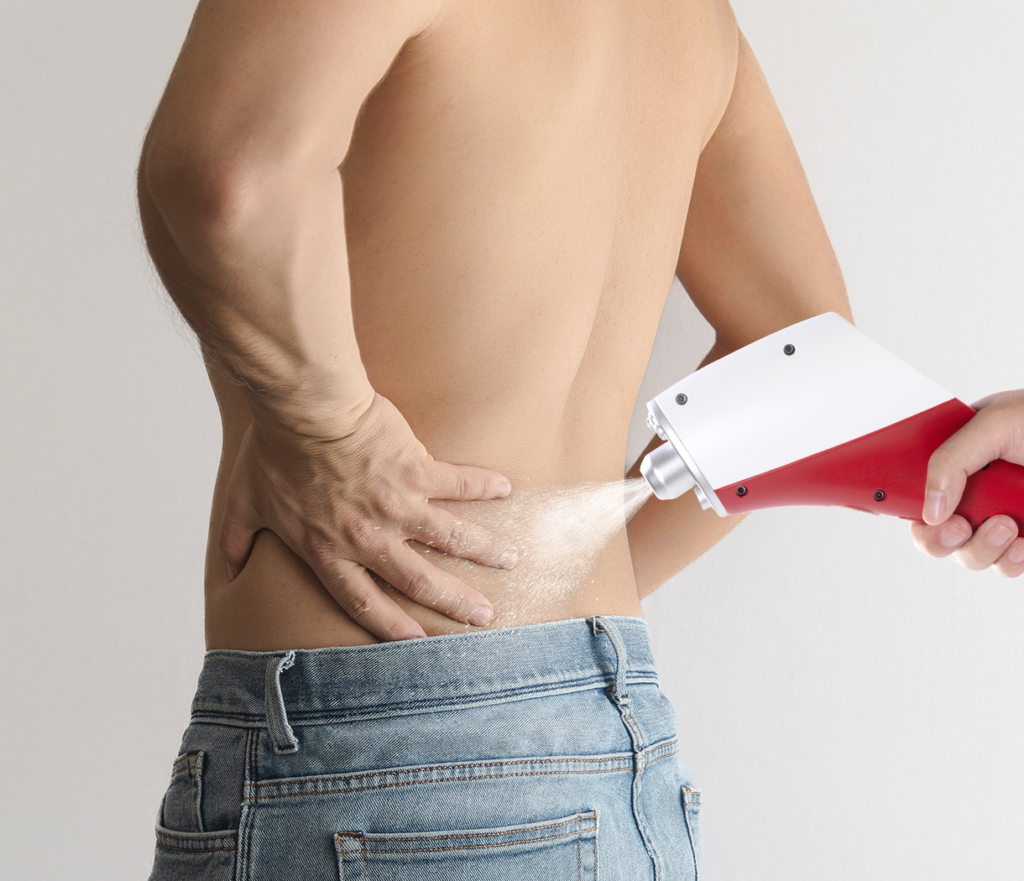Introduction
Sacroiliac joint dysfunction causes chronic lower back pain, often disrupting daily life. Traditional treatments may offer limited relief, prompting patients to seek advanced alternatives. CO₂ cryotherapy emerges as a cutting-edge solution, using -78°C carbon dioxide for 10–15 seconds to deliver precise, targeted cold therapy. Unlike basic ice packs, this controlled application addresses both acute inflammation and long-term pain patterns. The treatment works through multiple mechanisms—neural desensitization, anti-inflammatory effects, enhanced tissue oxygenation, and fascial relaxation—offering a comprehensive approach to SI joint pain. Clinical results show significant reductions in pain and improvements in mobility and quality of life. When integrated into broader rehab protocols, CO₂ cryotherapy represents a major advancement in musculoskeletal care.
Understanding Sacroiliac Joint Pain
The sacroiliac joint represents one of the most complex and frequently misunderstood anatomical structures in the human body, serving as a critical intersection between spinal biomechanics and pelvic stability. Understanding the intricate nature of sacroiliac joint dysfunction is essential for appreciating how targeted therapeutic interventions like CO₂ cryotherapy can provide significant clinical benefits.
What Is the Sacroiliac Joint?
The sacroiliac (SI) joint is a synovial joint connecting the sacrum and ilium at the back of the pelvis. Measuring around 17 cm, it has a unique L-shape and asymmetrical surfaces—fibrocartilage on the sacrum and hyaline cartilage on the ilium—that allow limited but vital motion. Strong ligaments, including the anterior, posterior, and interosseous sacroiliac ligaments, stabilize the joint while enabling essential movements during walking, running, and weight-bearing. The SI joint receives nerve input from L4-S3 and the superior gluteal nerve, often causing complex pain referral patterns when injured. Functionally, the SI joint absorbs shock and transfers forces between the spine and legs. It handles loads several times body weight, making it prone to injury and wear. Its normal range of motion includes 2–4 degrees of rotation and 1.6 mm of translation—small but critical for proper pelvic and gait mechanics.
Common Causes of SI Joint Pain
Biomechanical Dysfunction
- Muscle imbalances, poor posture, and repetitive strain can disrupt joint mechanics.
- Structural or functional leg length discrepancies create uneven joint loading.
Pregnancy and Childbirth
- Hormonal changes, particularly relaxin, cause ligament laxity and joint instability.
- Increased weight and altered posture during pregnancy place extra stress on the SI joint.
Trauma and Injury
- Falls, car accidents, and sports injuries may directly damage SI joint structures.
- Compensatory movement patterns post-injury can lead to chronic dysfunction.
Inflammatory Conditions
- Conditions like ankylosing spondylitis, psoriatic arthritis, and other spondyloarthropathies cause chronic joint inflammation.
Degenerative Changes
- Osteoarthritis of the SI joint due to aging or overuse leads to pain and reduced mobility.
Key Symptoms and Red Flags
Common Symptoms
- Deep, aching pain near the posterior superior iliac spine (PSIS), often on one side.
- Radiating discomfort into the buttock, groin, thigh, and sometimes the lateral leg or foot.
- Pain worsens with prolonged sitting, stair climbing, side-lying, or sit-to-stand transitions.
- Mechanical pain pattern: worsens with movement, improves with rest (some report morning stiffness).
Functional Limitations
- Difficulty with single-leg stance and rotational movements.
- Decreased walking tolerance and activity endurance.
- Compensatory movement patterns may affect the lumbar spine, hips, or pelvic floor.
Red Flags (Require Immediate Attention)
- Constant, severe pain unrelieved by positional changes.
- Neurological signs: numbness, tingling, or weakness in the legs.
- Bowel or bladder dysfunction.
- Fever or infection signs with back pain.
- History of cancer with new back pain onset.
What Is CO₂ Cryotherapy?
CO₂ cryotherapy represents a sophisticated advancement in therapeutic cold application, utilizing the unique properties of carbon dioxide to deliver precise, controlled cooling for therapeutic benefit. This innovative modality has emerged as a game-changing treatment option for various musculoskeletal conditions, offering advantages over traditional cryotherapy methods through its ability to achieve specific temperatures and treatment durations that optimize therapeutic outcomes.
How CO₂ Cryotherapy Works
The fundamental mechanism of CO₂ cryotherapy lies in its ability to create controlled thermal shock through rapid, precise cooling of target tissues. Understanding the multiple physiological responses triggered by this therapeutic modality provides insight into its remarkable efficacy in treating sacroiliac joint dysfunction and other musculoskeletal conditions.
Rapid Skin Cooling
CO₂ cryotherapy cools skin instantly to -78°C by releasing pressurized carbon dioxide, creating a fast thermal gradient that penetrates deep tissues. This rapid drop triggers vasoconstriction and lowers metabolic activity, reducing inflammation without damaging tissues. Each 10–15 second application precisely controls temperature, avoiding overcooling. Thermoreceptors in the skin respond by initiating physiological reactions that enhance healing. Unlike ice packs, CO₂ offers consistent and faster results. The method reduces oxygen demand and helps limit secondary tissue damage, especially useful for acute SI joint inflammation.
Thermal Shock Response
The thermal shock caused by CO₂ cryotherapy leads to immediate vasoconstriction followed by reactive hyperemia, improving blood flow and waste clearance. This cycle supports healing and reduces inflammation. At the cellular level, cold exposure activates protective proteins and pathways that strengthen tissue resilience. The process also promotes anti-inflammatory mediator production and reduces harmful cytokines. This hormetic stress response plays a major role in tissue repair and immune system modulation, boosting long-term recovery.
Neural Desensitization
CO₂ cryotherapy reduces nerve conduction velocity in A-delta and C-fibers, blocking pain signals and providing fast, lasting relief. This aligns with the gate control theory of pain, where cold stimulus inhibits pain perception. Cold also activates large mechanoreceptors, further suppressing pain at the spinal level. The neurological effect helps patients engage in rehab with less discomfort. Unlike medications, this method has minimal side effects and can offer extended relief well beyond the session.
Inflammation Modulation
CO₂ cryotherapy reduces key inflammatory markers (e.g., IL-6, VEGF, PGE2) and decreases oxidative stress. Cooling the tissue slows metabolism and vessel permeability, lowering the release of inflammatory chemicals while enhancing anti-inflammatory responses. This dual modulation shortens recovery time and relieves pain, especially in conditions like arthritis or SI joint inflammation. The anti-inflammatory benefits go beyond surface cooling by altering the core pathways driving inflammation and tissue degradation.
Improved Oxygenation
After initial vasoconstriction, CO₂ cryotherapy triggers reactive hyperemia that boosts blood circulation. This improves oxygen delivery, nutrient supply, and waste removal in the affected area. Better oxygenation enhances cellular healing and reduces chronic inflammation around the SI joint. The cycle of constriction and dilation also supports systemic circulation benefits. For chronic cases with poor tissue oxygenation, this mechanism significantly enhances recovery outcomes.
Fascial Relaxation
CO₂ cryotherapy relaxes fascia by reducing tissue viscosity and muscle tension. The cold alters the viscoelastic properties of fascia, improving mobility and decreasing stiffness. It also lowers muscle guarding through reflexive pathways, easing restrictions in areas like the thoracolumbar fascia and piriformis—key influencers of SI joint function. This fascial release helps restore normal joint mechanics, reduce pain, and improve movement efficiency, especially in those with postural or movement dysfunctions.
Benefits Over Traditional Cryotherapy
CO₂ cryotherapy offers faster, more precise, and more comfortable treatment than traditional ice therapy. While ice requires 15–20 minutes, CO₂ achieves better results in just 10–15 seconds, improving efficiency and patient compliance. Its rapid action enables multiple areas to be treated quickly, with minimal risk of cold-induced tissue damage. Unlike ice, which varies in temperature due to application method or ambient conditions, CO₂ consistently delivers -78°C with precision. This control ensures reliable, reproducible outcomes. Traditional methods often suffer from inconsistent cooling, reducing treatment effectiveness. Patient comfort is another key benefit. CO₂’s brief, targeted application causes less discomfort than prolonged icing, which can lead to numbness, irritation, and poor tolerance. Because CO₂ cryotherapy is less unpleasant and more effective, patients are more likely to complete full treatment courses and achieve better results—especially in managing sacroiliac joint pain.

Why Use CO₂ Cryotherapy for SI Joint Pain?
The application of CO₂ cryotherapy for sacroiliac joint dysfunction represents a targeted therapeutic approach that addresses the multiple pathophysiological mechanisms underlying this complex condition. The unique properties of CO₂ cryotherapy make it particularly well-suited for treating the inflammatory, neural, and biomechanical components of sacroiliac joint pain, offering patients a comprehensive treatment option that can significantly improve outcomes when integrated into appropriate care plans.
Pain Reduction through Neural Desensitization
CO₂ cryotherapy provides rapid, lasting pain relief by temporarily disrupting pain signal transmission through peripheral nerves. This effect creates a therapeutic window that allows patients to engage in rehab and exercise with less discomfort. It’s especially helpful for acute flare-ups or chronic cases unresponsive to other treatments. Pain relief from neural desensitization can last hours to days, improving function and allowing participation in activities that promote long-term recovery. This leads to a positive feedback loop—less pain enables more movement, which supports healing. Because the cooling effect is precisely targeted, CO₂ therapy numbs the painful area without affecting surrounding tissues. This specificity is crucial in complex areas like the sacroiliac joint, where multiple pain sources may coexist. Importantly, the effect is temporary and does not damage nerve function, making it both effective and safe.
Anti-Inflammatory Effects
CO₂ cryotherapy effectively reduces inflammation—a major contributor to sacroiliac joint dysfunction. The intense cold lowers local tissue temperature, decreasing inflammatory mediators, vascular permeability, and immune overactivity. These targeted effects help break the cycle of pain and swelling, especially in joints that face constant biomechanical stress like the SI joint. Unlike systemic medications, CO₂ cryotherapy offers localized relief without broad side effects. It’s especially beneficial for inflammatory conditions like spondyloarthropathies, offering a non-pharmacological complement to other treatments. CO₂ cryotherapy can also reduce dependence on NSAIDs or corticosteroids by delivering direct, precise anti-inflammatory action to the affected area. By reducing both pain and inflammation, CO₂ therapy supports healing while improving patient comfort and mobility, laying a better foundation for rehab and long-term management.
Improved Mobility and Function
CO₂ cryotherapy enhances mobility by reducing pain, relaxing fascia, and improving tissue healing. Sacroiliac joint dysfunction often causes stiffness, limited motion, and compensatory movements. CO₂ therapy addresses these issues at multiple levels. The cold reduces fascial tightness—especially in key areas like the thoracolumbar fascia and piriformis—allowing freer movement and less mechanical strain on the joint. Reduced pain lets patients walk, climb stairs, and perform transitions more easily. Improved circulation following cryotherapy boosts oxygen and nutrient delivery, helping tissues repair and regenerate. This effect is essential for restoring normal biomechanics and long-term joint function. By targeting both symptoms and root causes, CO₂ cryotherapy helps break the cycle of immobility and pain, enabling patients to regain function and return to daily activities faster.
Integration with Rehab Programs
CO₂ cryotherapy pairs seamlessly with rehab programs, enhancing outcomes for sacroiliac joint dysfunction. Its immediate pain relief and mobility gains create ideal conditions for physical therapy, exercise, and manual interventions. Used before sessions, cryotherapy reduces pain and stiffness, enabling better movement and effort. After rehab, it can minimize inflammation and soreness, supporting recovery and consistency in training. Its anti-inflammatory and tissue-healing effects help patients tolerate exercise better, accelerate rehab progress, and reduce setbacks. CO₂ therapy’s flexibility in timing and application makes it a valuable tool for customizing care. By supporting each phase of rehabilitation—from pain control to functional recovery—CO₂ cryotherapy becomes an effective and integrative element of long-term musculoskeletal treatment plans.
Clinical Evidence and Case Studies
The growing body of clinical evidence supporting the use of cryotherapy for musculoskeletal conditions provides a strong foundation for understanding the potential benefits of CO₂ cryotherapy in treating sacroiliac joint dysfunction. While research specific to C0₂ cryotherapy and sacroiliac joint dysfunction continues to evolve, existing evidence from related applications and similar conditions demonstrates the significant therapeutic potential of this innovative treatment modality.
Research on Cryotherapy for Musculoskeletal Conditions
Studies consistently support cryotherapy’s effectiveness in musculoskeletal care. One study on whole-body cryotherapy found significant improvements in chronic low back pain, along with reduced inflammatory markers and increased anti-inflammatory activity—key for spinal and sacroiliac joint disorders. Research has shown cryotherapy reduces pro-inflammatory cytokines like IL-6, IL-1β, and TNF-α, which are involved in sacroiliac joint dysfunction. This supports its use as a biologically targeted treatment. Cryotherapy’s neural desensitization and gate control effects explain its success in reducing chronic pain, enabling functional improvements and better quality of life. Physiological studies reveal additional benefits: improved blood flow, metabolic regulation, and activation of cellular repair pathways. These changes explain how cryotherapy delivers both immediate relief and lasting recovery benefits for patients with inflammatory or chronic musculoskeletal conditions.
Case Reports on SI Joint Treatment
Clinical case reports highlight how cryotherapy benefits sacroiliac joint (SI) dysfunction by reducing pain and inflammation. Different forms of cryotherapy have shown efficacy in managing a variety of SI-related conditions. Patients in these reports often experience significant pain relief, better mobility, and enhanced quality of life, confirming that cryotherapy’s mechanisms—pain modulation, anti-inflammatory effects, and tissue repair—translate into real-world results. Many reports describe improved outcomes when cryotherapy is combined with physical therapy or manual interventions. This integrated approach enhances treatment success, suggesting cryotherapy works best within a broader rehab program. Long-term case follow-ups show that cryotherapy’s benefits are durable, especially when combined with exercise and lifestyle changes. This makes it a reliable component in managing chronic SI joint issues over time.
Who Benefits Most from CO₂ Cryotherapy?
Identifying ideal candidates helps optimize outcomes. While many with sacroiliac joint dysfunction can benefit, certain groups respond especially well:
Patients with acute sacroiliac joint dysfunction
- First-time or recently worsened symptoms
- Benefit from strong anti-inflammatory effects
- Experience rapid pain relief and improved mobility
- Ideal as a first-line treatment for acute cases
Athletes and active individuals
- Need quick recovery to maintain training/competition
- Appreciate fast treatment with minimal downtime
- Reduced risk of chronic dysfunction development
Patients with inflammatory sacroiliac joint conditions
- Includes those with ankylosing spondylitis, psoriatic arthritis, etc.
- CO₂ cryotherapy supports symptom control as an adjunct to medical therapy
- Helps improve pain and functional capacity
Postpartum women
- Hormonal changes and physical strain from pregnancy can cause SI dysfunction
- Non-drug treatment option suitable for breastfeeding mothers
- Supports recovery without systemic medications
Patients unresponsive to traditional therapies
- Those who’ve had limited success with ice packs, medications, or other conservative care
- Benefit from cryotherapy’s unique delivery and deeper mechanisms of action
Elderly individuals
- Safe and non-invasive for patients with multiple health issues
- Minimal risk of interaction with medications
- Helpful for age-related sacroiliac degeneration and chronic inflammation

FAQs
No. Most patients describe the sensation as a brief cold spray. The treatment lasts only 10–15 seconds and is generally well-tolerated.
Many patients notice improvement after just one session. For sustained benefits, 3–6 sessions spaced over several weeks may be recommended.
Yes. CO₂ cryotherapy is effective for both recent flare-ups and persistent chronic pain, offering quick relief and long-term improvement.
Yes. It’s non-invasive and drug-free, making it a safe option for postpartum women, including those who are breastfeeding.
Pain relief may last from several hours to a few days. With regular sessions and rehab support, long-term relief is achievable.
Absolutely. It complements physical therapy, manual therapy, and medications, enhancing overall recovery and rehabilitation outcomes.
Summary: Cool Your Pain, Warm Up Your Life
Sacroiliac joint dysfunction can freeze your quality of life—but CO₂ cryotherapy is here to thaw it out. With ultra-fast treatment times, pinpoint accuracy, and impressive anti-inflammatory effects, this cutting-edge technique delivers results that traditional cold therapy simply can’t match. It reduces pain, boosts mobility, and enhances the effectiveness of rehab—all in just seconds. Whether you’re an athlete, new mom, or battling chronic pain, CO₂ cryotherapy offers a safe, effective, and non-invasive path back to function and freedom. It’s time to cool the pain and reignite the way you move.



